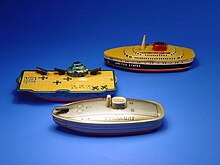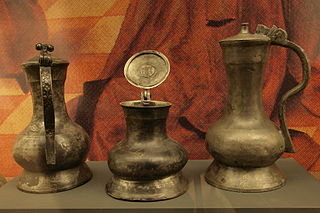
A tin toy, or tin lithograph toy, is a mechanical toy made out of tinplate and colorfully painted by chromolithography to resemble primarily a character or vehicle. [1]

A tin toy, or tin lithograph toy, is a mechanical toy made out of tinplate and colorfully painted by chromolithography to resemble primarily a character or vehicle. [1]

Tinplate was used in the manufacture of toys beginning in the mid-19th century. The invention of sheet metal stamping machines in 1815 allowed for the mass production of inexpensive toys. Tin toys were made from thin sheets of steel plated with tin, hence the name tinplate. [2] Tin toys were a cheap and durable substitute for wooden toys. The toys were originally assembled and painted by hand. Spring activated tin toys originated in Germany in the 1850s. [3] In the late 1880s offset lithography was used to print designs on tinplate. After the colorful designs were printed on the metal, they were formed by dies and assembled with small tabs. The lightweight nature of the toys allowed them to be shipped less expensively and easier than the heavier cast iron toys.
Germany was the major producer of tin toys in the world in the early 20th century. The most famous German manufacturer of tin toys was Ernst Paul Lehmann who is said to have exported 90% of his toys. [4] France and England joined the fray and it wasn't long before hundreds of thousands of these penny toys were being manufactured. Production of tin toys in the United States started earlier, but began in earnest when tin ore mines were opened in Illinois providing easily available and cheap raw materials. A number of manufactures scrambled to catch up in the beginning of the 20th century, but it wasn't until after World War I, with anti-German sentiment high, that they began to make real gains. There was a growing demand for American produced products and by the 1920s American firms had overtaken the competition. The largest and most successful firm from the 1920s to the 1960s was Louis Marx and Company. Marx produced a huge number of designs and depended on large sales volumes to keep prices down. [5]

The production of tin toys was discontinued during World War II because of the need for raw materials in the war effort. After the war, tin toys continued to increase in popularity in England through Chad Valley toys [6] and also were produced in large numbers in Japan. Under occupation, manufacturers in Japan were granted the right to resume production. The idea was to give Japan all of the low profit; high labor manufacturing and the US companies could sell the imported product. It worked better than they had expected and Japan became a tin toy manufacturing force until the end of the 1950s. In the 1960s cheaper plastic and new government safety regulations ended the reign of tin toys. Presently, China has taken over the role of the leading tin toy manufacturing country. [7]
Tin toy robots are a highly collectable type of tin toy. [8] Classics like the Mr Atomic Robot, and Robby the Robot from the movie Forbidden Planet can sell for several thousand dollars.

O scale is a scale commonly used for toy trains and rail transport modelling. Introduced by German toy manufacturer Märklin around 1900, by the 1930s three-rail alternating current O gauge was the most common model railroad scale in the United States and remained so until the early 1960s. In Europe, its popularity declined before World War II due to the introduction of smaller scales.

Louis Marx and Company was an American toy manufacturer in business from 1919 to 1980. They made many types of toys including tin toys, toy soldiers, toy guns, action figures, dolls, toy cars and model trains. Some of their notable toys are Rock'em Sock'em Robots, Big Wheel tricycles, Disney branded dollhouses and playsets based on TV shows like Gunsmoke. Its products were often imprinted with the slogan "One of the many Marx toys, have you all of them?"
The Ives Manufacturing Company, an American toy manufacturer from 1868 to 1932, was the largest manufacturer of toy trains in the United States from 1910 until 1924, when Lionel Corporation overtook it in sales.

A toy train is a toy that represents a train. It is distinguished from a model train by an emphasis on low cost and durability, rather than scale modeling. A toy train can be as simple as a toy that can run on a track, or it might be operated by electricity, clockwork or live steam. It is typically constructed from wood, plastic or metal. Many of today's steam trains might be considered as real ones as well, providing they are not strictly scale or not enough detailed ones in favor of a robustness appropriate for children or an inexpensive production.

The Hafner Manufacturing Company was a maker of tinplate clockwork-powered O gauge toy trains, based in Chicago, Illinois, from 1914 to 1951. It was formed when its founder, William Frederick Hafner, a co-founder of American Flyer, left the company in favor of creating his own company.

A toy soldier is a miniature figurine that represents a soldier. The term applies to depictions of uniformed military personnel from all eras, and includes knights, cowboys, American Indians, pirates, samurai, and other subjects that involve combat-related themes. Toy soldiers vary from simple playthings to highly realistic and detailed models. The latter are of more recent development and are sometimes called model figures to distinguish them from traditional toy soldiers. Larger scale toys such as dolls and action figures may come in military uniforms, but they are not generally considered toy soldiers.

All Metal Products Company was an American toy company founded in 1920 and based in Wyandotte, Michigan for most of its history. It produced inexpensive pressed metal toys under the Wyandotte brand name, and was the largest manufacturer of toy guns in the US for several decades in the 20th century. The company's slogan was "Wyandotte Toys are Good and Safe." To keep costs down, the company used scrap and surplus raw materials whenever possible, often manufacturing their toys from scrap metal obtained from local auto factories.

Biscuit tins are utilitarian or decorative containers used to package and sell biscuits and some confectionery. Invented by Huntley & Palmers in 1831, they are commonly found in households in Great Britain, Ireland, and Commonwealth countries, but also on continental Europe and French Canada. Popularity in the United States and English Canada spread later in the 20th century. Over 60% of UK households own a biscuit tin.

Chad Valley is a long-established brand of toys in the United Kingdom owned by Sainsbury's.
Meccano Ltd was a British toy manufacturing company, established in 1908 by Frank Hornby in Liverpool, England, to manufacture and distribute Meccano and other model toys and kits created by the company. During the 1920s and 1930s it became the biggest toy manufacturer in the United Kingdom and produced three of the most popular lines of toys in the twentieth century: Meccano, Hornby Trains and Dinky Toys.
Tinplate consists of sheets of steel coated with a thin layer of tin to impede rusting. Before the advent of cheap milled steel, the backing metal was wrought iron. While once more widely used, the primary use of tinplate now is the manufacture of tin cans.

A tinsmith is a person who makes and repairs things made of tin or other light metals. The profession may sometimes also be known as a tinner, tinker, tinman, or tinplate worker; whitesmith may also refer to this profession, though the same word may also refer to an unrelated specialty of iron-smithing. By extension it can also refer to the person who deals in tinware, or tin plate. Tinsmith was a common occupation in pre-industrial times.

Tinning is the process of thinly coating sheets of wrought iron or steel with tin, and the resulting product is known as tinplate. The term is also widely used for the different process of coating a metal with solder before soldering.

A tin ceiling is an architectural element, consisting of a ceiling finished with plates of tin with designs pressed into them, that was very popular in Victorian buildings in North America in the late 19th and early 20th century. They were also popular in Australia where they were commonly known as pressed metal ceilings or Wunderlich ceilings. They were also used in South Africa.

Tinware is any item made of prefabricated tinplate. Usually tinware refers to kitchenware made of tinplate, often crafted by tinsmiths. Many cans used for canned food are tinware as well. Something that is tinned after being shaped and fabricated is not considered tinware.

Metals used for architectural purposes include lead, for water pipes, roofing, and windows; tin, formed into tinplate; zinc, copper and aluminium, in a range of applications including roofing and decoration; and iron, which has structural and other uses in the form of cast iron or wrought iron, or made into steel. Metal alloys used in building include bronze ; brass ; monel metal and nickel silver, mainly consisting of nickel and copper; and stainless steel, with important components of nickel and chromium.

Metal House was founded as Marumiya in 1943; the company has produced some well-known tin toys. Especially familiar to collectors of battery-operated tin toy robots, the firm originally operated as a subcontractor producing toys for some of the most prolific Japanese toy companies such as Horikawa, Nomura, and Yonezawa during the post World War II heyday of tin toys.

Penny toys is a name used for inexpensive tin toys mostly manufactured in Germany between the 1880s and 1914 that were sold in the UK, Europe and America in the late 19th century and early 20th century.
Tata Tinplate, listed as The Tinplate Company of India Limited (TCIL), is a subsidiary of Tata Steel Ltd. Founded in 1920, TCIL is India's oldest and current largest tinplate manufacturer. TCIL has a 70% market share in India and exports a fourth of its products outside India.